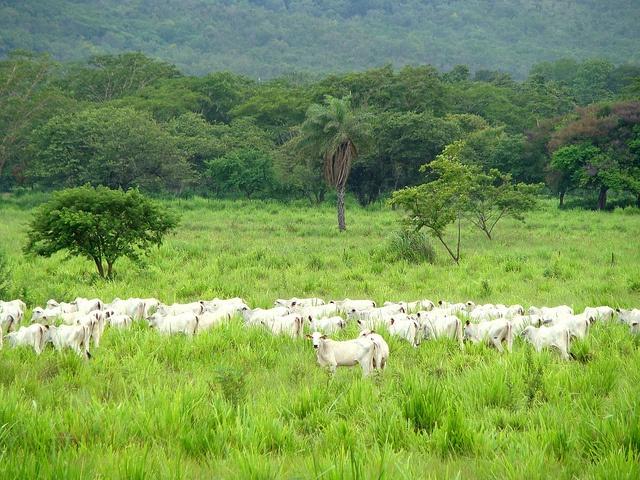
Global awareness of the ongoing deforestation across the Amazon biome first reached a fever pitch in the 1980s, when more consumers were persuaded of the connection between Brazil’s beef industry and deforestation.
McDonald’s, already facing criticism for its use of polystyrene packaging, became the focal point of global protests. The fast food giant eventually announced in 1989 that it would no longer source from any producers raising cattle in the Amazon, declared a huge win for environmental groups. A generation later, the Amazon would force McDonald’s under the spotlight again as its chicken products were linked to soy from the region and that crop’s contribution to deforestation. Hence the 2006 Soy Moratorium, long hailed for slowing what critics say is the destruction of Amazonian rain forests.
McDonald’s hit the news again with a summer announcement that it would once source beef from areas in the Amazon that, in the company's view, are producing sustainable and responsibly-raised cattle.
To critics, this move at the very least is puzzling, as McDonald’s pledged to remove any links to deforestation across its entire global supply chain last year. For a company that to many symbolizes craven "corporatization," the decision to procure beef from the Amazon after a 27-year hiatus comes across as a poorly thought-out public relations move.
After all, McDonald’s continues to struggle with sales as younger consumers flock to fast-casual chains and eateries that impart a social mission, such as Panera Bread and Chipotle. An all-day breakfast menu lifted McDonald’s out of its worst doldrums, but in Wall Street’s view, the company’s performance is still flat. Renewed business ties with beef producers in the Amazon, at first glance, appears to endanger the company's fragile reputation.
The truth about the beef raised for McDonald's in the Amazon, however, is far more nuanced.
McDonald’s first purchases of beef for its 800-plus restaurants in Brazil comes from a pilot program in the west-central state of Mato Grasso. This program, Novo Campo (“new field”), started in 2012 with 14 ranchers in the municipality of Alta Floresta. The initiative's backers say it engages the beef industry's entire value chain: Ranchers, slaughterhouses, producers and retailers are all required to follow a set list of sustainability commitments.
According to Instituto Centro de Vida (ICV), the program’s administrator, the benefits are numerous: improved land management, better water stewardship, more rigorous training, increased cattle stock density on land, reduced methane emissions and a superior quality of beef. ICV insists the cattle’s overall environmental impact has decreased, largely due to improved efficiency, which has long been a challenge for the Brazilian beef sector.
The stubborn fact is that Brazil is a sovereign nation, and will develop its natural capital, as in its forests, into financial assets as it sees fit. The country of 200 million is simply following the template of Europe and North America, which over centuries transformed their forests in the quest to evolve into wealthy industrial societies. True, NGOs can reply that Brazil does not want to make the same mistakes Western countries made, as in the heavy air pollution that long blanketed many European cities or America’s superfund sites -- not to mention Cleveland’s Cuyahoga River fire in 1969. But unless wealthier countries choose to compensate Brazil for not cutting down forests, at the same value at which the country gains financially for doing so, expect charges of hypocrisy to trump environmental concerns.
The best possible option is meeting somewhere in the middle. Some of those forests, even too many of these valuable lands throughout Brazil, may be gone. Nevertheless, at a minimum, that land can be managed well, used efficiently and foster sustainable economic development for local communities. The use of better grasses on these lands can reduce ranchers' environmental impacts. Careful stewardship of local water resources can create business opportunities for the manufacture of tanks and other local irrigation infrastructure needs. Locals can be hired to build fencing that hem in cattle and prevent further deforestation. And they can also be hired to work on these lands, knowing they will be treated fairly as companies such as McDonald's do not need any more dings on their reputations.
In contrast: If companies, including McDonald’s, pull out of a region, they also spurn the good work that is happening thanks to programs such as Novo Campo. Furthermore, those companies lose any leverage to influence and transform land management for the better. Abandoning the region hardly guarantees deforestation will stall; if anything, the complete lack of engagement will only increase the rate at which these forests disappear if more is not done to care for lands that are already developed.
Image credit: ICV/Flickr

Leon Kaye has written for 3p since 2010 and become executive editor in 2018. His previous work includes writing for the Guardian as well as other online and print publications. In addition, he's worked in sales executive roles within technology and financial research companies, as well as for a public relations firm, for which he consulted with one of the globe’s leading sustainability initiatives. Currently living in Central California, he’s traveled to 70-plus countries and has lived and worked in South Korea, the United Arab Emirates and Uruguay.
Leon’s an alum of Fresno State, the University of Maryland, Baltimore County and the University of Southern California's Marshall Business School. He enjoys traveling abroad as well as exploring California’s Central Coast and the Sierra Nevadas.














